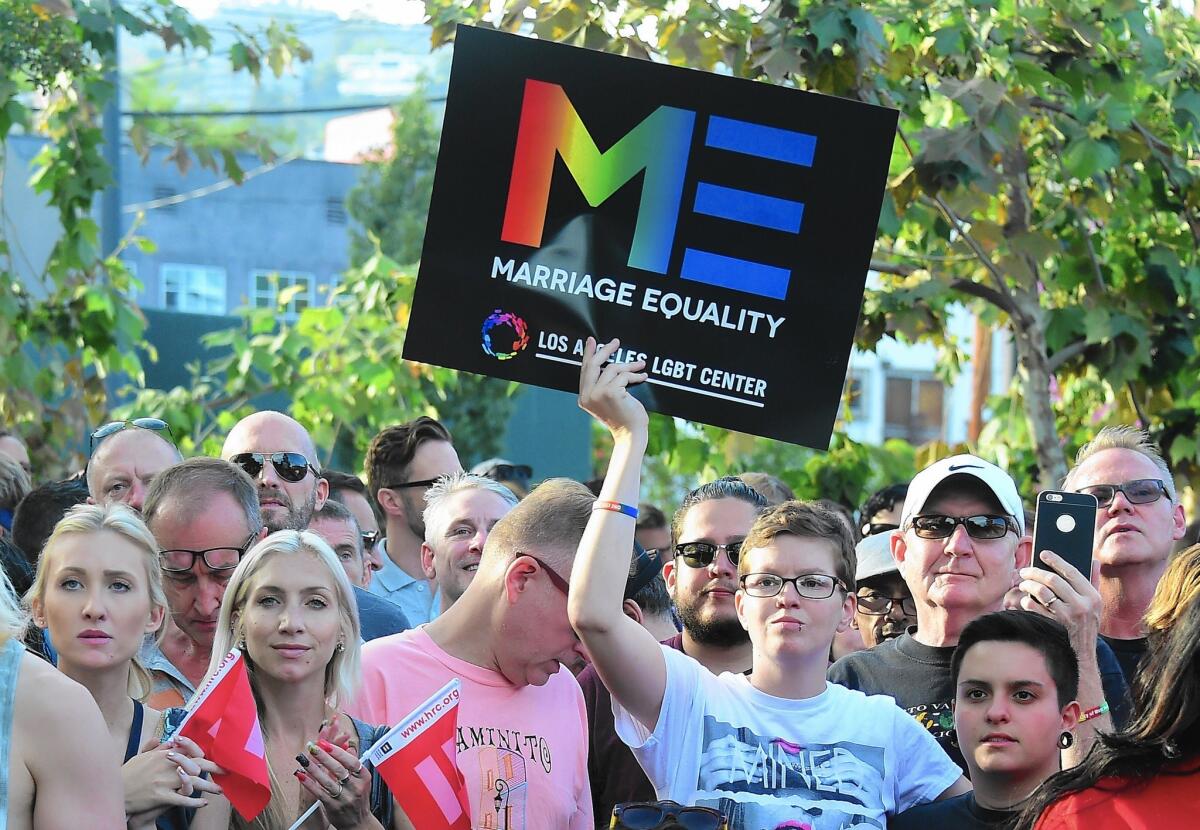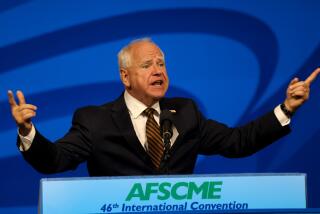LGBT activists say the fight doesn’t end at marriage

LGBT supporters gather for a rally in West Hollywood on June 26 to celebrate the U.S. Supreme Court decision clearing the way for same-sex marriages.
When Donald Jones Anspauch Jr. first started fighting for gay rights in the 1980s, there was an urgent, unifying cause for activists: AIDS.
His friends were dying. Devastated, Anspauch penned a coming-out letter to his parents saying, “Gay is OK,” and began marching, picketing and protesting for his and others’ survival. The fight eventually shifted to legalizing same-sex marriage, and Anspauch joined the cause.
After the Supreme Court cleared the way for nationwide same-sex marriage last month, Anspauch, 59, said he was ready for the next march.
“There are still people who face injustice,” he said. “Of course I’ll keep fighting.”
But where the fight goes next remains an open question. Amid the jubilation over the court decision, the lesbian, gay, bisexual and transgender rights movement finds itself at a crossroads. For decades, activists united under galvanizing causes like AIDS and marriage that created headlines and drove fundraising. In the wake of their major victory on marriage, advocates are quick to point out that the movement will keep going even as they ponder the next battle front.
Last month, the Los Angeles LGBT Center put out an email blast with the subject line “Our Next Steps.” The Oakland-based Transgender Law Center has been tweeting the hashtag #morethanmarriage. And the president of GLAAD stressed that “marriage is a benchmark, not a finish line.”
As the advocacy group Freedom to Marry announced that its “campaign is now accomplished,” and that it was closing its doors, it noted that “there is much to do still in the realm of LGBT rights.”
“I do think that there will be a sense among the general public that our winning the freedom to marry means the issues LGBT people still face will be wiped away and the slate will be clean,” said Kate Kendell, executive director of the San Francisco-based National Center for Lesbian Rights. There is some concern, she said, that the public will think LGBT people have won their battle and that their work is done.
“But for those of us who have been doing this work for some time, we’ve known for years that we would win the freedom to marry, so our work has been along multiple tracks,” she said.
Lorri L. Jean, chief executive of the Los Angeles LGBT Center, said movement leaders made a deliberate decision to focus on marriage in the 1990s, after a lawsuit in which three same-sex couples in Hawaii argued that being denied marriage licenses was discrimination. As the case progressed and it appeared Hawaii could become the first state to legalize gay marriage, Congress passed the federal Defense of Marriage Act, and states began considering same-sex marriage bans. (The Hawaii Supreme Court eventually dismissed the case after an amendment to the state constitution banned same-sex marriages.)
“Marriage got an incredible level of support in part because we were attacked across the country with states passing marriage bans and anti-gay ballot measures like [California’s] Proposition 8,” Jean said. “It will be harder to get people to be as passionate about other very important issues, but we’re just going to have to keep working on it.”
While the marriage issue became a broad unifying force, it’s unlikely another single issue will garner so much widespread attention soon, said Rick Zbur, executive director of Equality California. And that could pose challenges.
“The thing about marriage was that it was easy to understand and a unifying principle,” Zbur said. “Most movements don’t have a single, unifying principle, so we’ve got to do the hard work of educating the public bit by bit and issue by issue. ... The next phase is just going to be harder.”
So, what’s the next mainstream cause for the movement? There are plenty to choose from, advocates say.
Some say the next frontier is fighting for expanded federal civil rights laws to protect gays in the workplace and elsewhere. California is one of only 22 states and the District of Columbia with laws barring employment discrimination based on sexual orientation.Others say the movement should pivot the publicity and support gained in the marriage fight to combating LGBT homelessness, conversion therapy and youth suicide.
For others, it’s time to give more attention to the other letters in the LGBT acronym, especially the B (bisexual) and T (transgender).
Faith Cheltenham, president of the national bisexual organization BiNet USA, said she has been fighting for marriage equality for more than a decade.
But Cheltenham, a black bisexual woman, had mixed feelings after the Supreme Court ruling. She was happy with the outcome, but she was disheartened by seeing news stories focusing disproportionately on white gay men and using the term “gay marriage” instead of same-sex marriage.
“We are not functionally, practically an LGBT community,” she said. “We are rarely representative of all the identities. And there are a bunch of LGBT people who are ready to get out of the fight,” Cheltenham said. “They are ready to settle down with their wife or their husband.
“You can put up lights and have a big party, but the stories and the hurt and the rage that built this movement can’t get left behind.”
In the days following the Supreme Court decision, there has been widespread public discussion over the urgency of highlighting issues facing transgender people, such as violence against transgender women and high rates of suicide.
The transgender rights movement, activists say, is years behind the advances and visibility of the gay and lesbian movement. Kris Hayashi, executive director of the Transgender Law Center, said that while the freedom to marry is important, transgender advocates have been working hard outside the mainstream marriage fight.
The question now is, with the marriage fight over, will transgender rights get more attention?
“The issues facing transgender people are so urgent and critical — for many, literally a daily struggle for survival — that we don’t have the room or luxury for fatigue,” Hayashi said.
More to Read
Sign up for Essential California
The most important California stories and recommendations in your inbox every morning.
You may occasionally receive promotional content from the Los Angeles Times.











